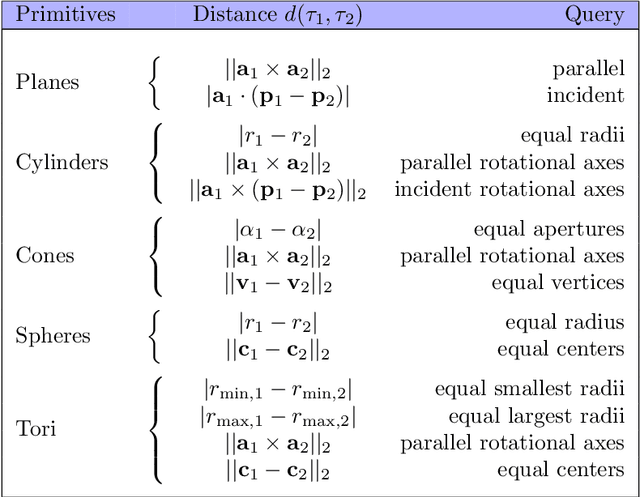Andrea Raffo
Recognising geometric primitives in 3D point clouds of mechanical CAD objects
Jan 11, 2023Abstract:The problem faced in this paper concerns the recognition of simple and complex geometric primitives in point clouds resulting from scans of mechanical CAD objects. A large number of points, the presence of noise, outliers, missing or redundant parts and uneven distribution are the main problems to be addressed to meet this need. In this article we propose a solution, based on the Hough transform, that can recognize simple and complex geometric primitives and is robust to noise, outliers, and missing parts. Additionally, we can extract a series of geometric descriptors that uniquely characterize a primitive and, based on them, aggregate the output into maximal or compound primitives, thus reducing oversegmentation. The results presented in the paper demonstrate the robustness of the method and its competitiveness with respect to other solutions proposed in the literature.
Fitting and recognition of geometric primitives in segmented 3D point clouds using a localized voting procedure
May 30, 2022



Abstract:The automatic creation of geometric models from point clouds has numerous applications in CAD (e.g., reverse engineering, manufacturing, assembling) and, more in general, in shape modelling and processing. Given a segmented point cloud representing a man-made object, we propose a method for recognizing simple geometric primitives and their interrelationships. Our approach is based on the Hough transform (HT) for its ability to deal with noise, missing parts and outliers. In our method we introduce a novel technique for processing segmented point clouds that, through a voting procedure, is able to provide an initial estimate of the geometric parameters characterizing each primitive type. By using these estimates, we localize the search of the optimal solution in a dimensionally-reduced parameter space thus making it efficient to extend the HT to more primitives than those that are generally found in the literature, i.e. planes and spheres. Then, we extract a number of geometric descriptors that uniquely characterize a segment, and, on the basis of these descriptors, we show how to aggregate parts of primitives (segments). Experiments on both synthetic and industrial scans reveal the robustness of the primitive fitting method and its effectiveness for inferring relations among segments.
Fit4CAD: A point cloud benchmark for fitting simple geometric primitives in CAD models
May 14, 2021



Abstract:We propose Fit4CAD, a benchmark for the evaluation and comparison of methods for fitting simple geometric primitives in point clouds representing CAD models. This benchmark is meant to help both method developers and those who want to identify the best performing tools. The Fit4CAD dataset is composed by 225 high quality point clouds, each of which has been obtained by sampling a CAD model. The way these elements were created by using existing platforms and datasets makes the benchmark easily expandable. The dataset is already split into a training set and a test set. To assess performance and accuracy of the different primitive fitting methods, various measures are defined. To demonstrate the effective use of Fit4CAD, we have tested it on two methods belonging to two different categories of approaches to the primitive fitting problem: a clustering method based on a primitive growing framework and a parametric method based on the Hough transform.
Reverse engineering of CAD models via clustering and approximate implicitization
Oct 17, 2018



Abstract:In applications like computer aided design, geometric models are often represented numerically as polynomial splines or NURBS, even when they originate from primitive geometry. For purposes such as redesign and isogeometric analysis, it is of interest to extract information about the underlying geometry through reverse engineering. In this work we develop a novel method to determine these primitive shapes by combining clustering analysis with approximate implicitization. The proposed method is automatic and can recover algebraic hypersurfaces of any degree in any dimension. In exact arithmetic, the algorithm returns exact results. All the required parameters, such as the implicit degree of the patches and the number of clusters of the model, are inferred using numerical approaches in order to obtain an algorithm that requires as little manual input as possible. The effectiveness, efficiency and robustness of the method are shown both in a theoretical analysis and in numerical examples implemented in Python.
 Add to Chrome
Add to Chrome Add to Firefox
Add to Firefox Add to Edge
Add to Edge